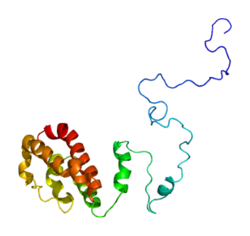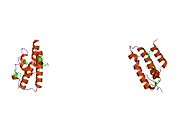- DNAJC6
-
DnaJ (Hsp40) homolog, subfamily C, member 6 
PDB rendering based on 1n4c.Available structures PDB 1n4c, 1nz6, 1xi5 Identifiers Symbols DNAJC6; DJC6; KIAA0473; MGC129914; MGC129915; MGC48436 External IDs OMIM: 608375 MGI: 1919935 HomoloGene: 8865 GeneCards: DNAJC6 Gene EC number 3.1.3.48 Gene Ontology Molecular function • protein tyrosine phosphatase activity
• hydrolase activity
• SH3 domain binding
• heat shock protein bindingCellular component • cytosol Biological process • post-Golgi vesicle-mediated transport
• cellular membrane organizationSources: Amigo / QuickGO Orthologs Species Human Mouse Entrez 9829 72685 Ensembl ENSG00000116675 ENSMUSG00000028528 UniProt O75061 Q80TZ3 RefSeq (mRNA) NM_014787 NM_198412 RefSeq (protein) NP_055602 NP_940804 Location (UCSC) Chr 1:
65.71 – 65.88 MbChr 4:
101.17 – 101.32 MbPubMed search [1] [2] Putative tyrosine-protein phosphatase auxilin is an enzyme that in humans is encoded by the DNAJC6 gene.[1][2][3]
DNAJC6 belongs to the evolutionarily conserved DNAJ/HSP40 family of proteins, which regulate molecular chaperone activity by stimulating ATPase activity. DNAJ proteins may have up to 3 distinct domains: a conserved 70-amino acid J domain, usually at the N terminus, a glycine/phenylalanine (G/F)-rich region, and a cysteine-rich domain containing 4 motifs resembling a zinc-finger domain (Ohtsuka and Hata, 2000).[supplied by OMIM][3]
References
- ^ Seki N, Ohira M, Nagase T, Ishikawa K, Miyajima N, Nakajima D, Nomura N, Ohara O (Feb 1998). "Characterization of cDNA clones in size-fractionated cDNA libraries from human brain". DNA Res 4 (5): 345–9. doi:10.1093/dnares/4.5.345. PMID 9455484.
- ^ Ohtsuka K, Hata M (Jan 2001). "Mammalian HSP40/DNAJ homologs: cloning of novel cDNAs and a proposal for their classification and nomenclature". Cell Stress Chaperones 5 (2): 98–112. doi:10.1379/1466-1268(2000)005<0098:MHDHCO>2.0.CO;2. PMC 312896. PMID 11147971. http://www.pubmedcentral.nih.gov/articlerender.fcgi?tool=pmcentrez&artid=312896.
- ^ a b "Entrez Gene: DNAJC6 DnaJ (Hsp40) homolog, subfamily C, member 6". http://www.ncbi.nlm.nih.gov/sites/entrez?Db=gene&Cmd=ShowDetailView&TermToSearch=9829.
Further reading
- Gregory SG, Barlow KF, McLay KE, et al. (2006). "The DNA sequence and biological annotation of human chromosome 1.". Nature 441 (7091): 315–21. doi:10.1038/nature04727. PMID 16710414.
- Gerhard DS, Wagner L, Feingold EA, et al. (2004). "The status, quality, and expansion of the NIH full-length cDNA project: the Mammalian Gene Collection (MGC).". Genome Res. 14 (10B): 2121–7. doi:10.1101/gr.2596504. PMC 528928. PMID 15489334. http://www.pubmedcentral.nih.gov/articlerender.fcgi?tool=pmcentrez&artid=528928.
- Suzuki Y, Yamashita R, Shirota M, et al. (2004). "Sequence comparison of human and mouse genes reveals a homologous block structure in the promoter regions.". Genome Res. 14 (9): 1711–8. doi:10.1101/gr.2435604. PMC 515316. PMID 15342556. http://www.pubmedcentral.nih.gov/articlerender.fcgi?tool=pmcentrez&artid=515316.
- Scheele U, Alves J, Frank R, et al. (2003). "Molecular and functional characterization of clathrin- and AP-2-binding determinants within a disordered domain of auxilin.". J. Biol. Chem. 278 (28): 25357–68. doi:10.1074/jbc.M303738200. PMID 12732633.
- Strausberg RL, Feingold EA, Grouse LH, et al. (2003). "Generation and initial analysis of more than 15,000 full-length human and mouse cDNA sequences.". Proc. Natl. Acad. Sci. U.S.A. 99 (26): 16899–903. doi:10.1073/pnas.242603899. PMC 139241. PMID 12477932. http://www.pubmedcentral.nih.gov/articlerender.fcgi?tool=pmcentrez&artid=139241.
- Scheele U, Kalthoff C, Ungewickell E (2001). "Multiple interactions of auxilin 1 with clathrin and the AP-2 adaptor complex.". J. Biol. Chem. 276 (39): 36131–8. doi:10.1074/jbc.M106511200. PMID 11470803.
- Ishikawa K, Nagase T, Nakajima D, et al. (1998). "Prediction of the coding sequences of unidentified human genes. VIII. 78 new cDNA clones from brain which code for large proteins in vitro.". DNA Res. 4 (5): 307–13. doi:10.1093/dnares/4.5.307. PMID 9455477.
PDB gallery Chaperones/
protein foldingOtherProtein targeting Ubiquitin E1 Ubiquitin-activating enzyme (UBA1, UBA2, UBA3, UBA5, UBA6, UBA7, ATG7, NAE1, SAE1)
E2 Ubiquitin-conjugating enzyme (A • B • C • D1, D2, D3 • E1, E2, E3 • G1, G2 • H • I • J1, J2 • K • L1, L2, L3, L4, L6 • M • N • O • Q1, Q2 • R1 (CDC34), R2 • S • V1, V2 • Z)
E3 Ubiquitin ligase (VHL, Cullin, CBL, MDM2, FANCL, UBR1)
Deubiquitinating enzyme: Ataxin 3 • USP6 • CYLD
ATG3 • BIRC6 • UFC1Other see also posttranslational modification disorders
B bsyn: dna (repl, cycl, reco, repr) · tscr (fact, tcrg, nucl, rnat, rept, ptts) · tltn (risu, pttl, nexn) · dnab, rnab/runp · stru (domn, 1°, 2°, 3°, 4°)Categories:- Human proteins
- Chromosome 1 gene stubs
- Heat shock proteins
Wikimedia Foundation. 2010.


